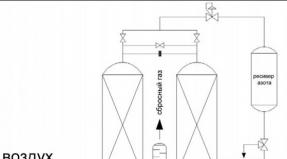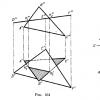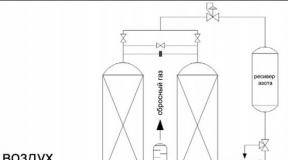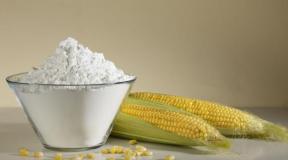Siberian grape varieties. Grape varieties for Bashkiria Grape nursery of Bashkiria
The picture of climatic conditions in Bashkiria is quite complex. It has a continental climate, characterized by fairly warm summers and snowy, cold and long winters.
Weather conditions change frequently due to cyclones coming from the temperate latitudes, which encounter invading Arctic air and winter anticyclones from Siberia. However, even in such rather difficult conditions, local winegrowers successfully grow many varieties and hybrid forms of grapes.
Criteria for selecting grapes for Bashkiria
The climate in Bashkiria is quite suitable for cultivating grapes. To grow productive grapes in Bashkiria, you should give preference to zoned varieties and hybrids that are adapted to the climate and bear fruit well in the conditions of this region. The very first varieties for cultivation in places uncharacteristic for this heat-loving crop were bred by Michurin.
Nowadays, breeders have been able to obtain a large number of new and promising forms of grapes for cultivation in unfavorable climatic conditions. Such varieties are characterized by early ripening, resistance to weather factors and high yield. A large number of early and ultra-early ripening periods have been developed, which are optimally suited for cultivation on the territory of Bashkiria.

The best grape varieties for Bashkiria
The choice of variety or hybrid form of grapes for cultivation in Bashkiria should be approached very responsibly. Only zoned varieties adapted to the climate are capable of producing high and high-quality yields.
| Name of grape variety or NGF | Description of the grape bush | Description of berries and yield | Features of the variety or NGF of grapes |
| "Alexander" | The plant is of medium height, the cluster weighs 137 g, cylindrical, branching is often observed | The berries are medium-sized, oblong-elongated, dark pink in color, fleshy, with an accumulation of sugars up to 18%. Productivity is stable and high | Super early. Universal purpose. Originator: Bashkir NPO. Increased resistance to diseases. Increased winter hardiness |
| "Bashkir early" | Plants of medium height, require pollination. The bunch is small, loose, with an average weight of no more than 28 g | The berry is relatively small, round, purple in color, with an average weight of 0.8 g. The skin is dense, the flesh is juicy, and has a sweet and sour taste. Average yields are 145.1 c/ha | Extra early variety. Bred at the Bashkir Institute of Agriculture and Selection. Winter-hardy variety, resistant to mildew, but affected by oidium |
| "Anniversary" | Bush growth is strong. The clusters are medium, weighing 122 g. Conical shape, maybe winged | The berry is medium, round, golden in color with a green tint. The flesh is fleshy, with a crunch. The taste is nutmeg. Average yield 121 c/ha | Very early ripening table variety. Has increased resistance to diseases and pests |
| "Vasily" | Medium vigor, compact bunch weighing up to 215 g | The berries are blackish-blue, elongated in shape, with a sugar content of up to 16.1% | Early ripening. High winter hardiness |
| "Pineapple Madeleine" | A plant with medium vigor, clusters of medium density, conical or cylindrical-conical shape, weighing up to 215 g | The berry is medium, oblong, oval, white in color, the pulp is tasty and juicy. Productivity from each bush up to 4.56 kg | Table variety from the Moscow Timiryazev Agricultural Academy. Affected by diseases at a level of 40%, spider mites - 60% |
| "Squeen's Dream" | Average vigor of bush growth, cylindrical bunch, weighing up to 215 g | The berries are medium-sized, oval, reddish-brown in color. Productivity per bush is almost 4 kg | Universal grape variety, early. Disease incidence without treatment does not exceed 60% |
| "White Miracle" | Medium height. A bunch weighing 1.50 kg or more, beautiful, moderately loose consistency | The berry is very large, up to 15 g, white, oblong-round. The pulp is fleshy, juicy, the taste is very pleasant. Productivity is quite high | Ultra-early ripening. Increased resistance to mildew, oidium, gray rot |
| "Bashkir emerald" | Bushes of medium vigor, with well-ripening, powerful shoots | The berries are round-oval, green, and at the full ripening phase acquire a golden color and transparency. Slight waxy coating, very original and sweet taste | Table, very early ripening. Bred by the Bashkir PYaOS. Increased winter hardiness |
How to grow grapes in Bashkiria (video)
Preparation and planting of seedlings
It is quite easy to grow grapes in Bashkiria if you follow the planting technology. When preparing seedlings for planting, they are sorted. Today, varieties are often grown in Bashkiria that are not inferior in quality to grapes from the southern regions. The agricultural technology of planting and growing is very simple and accessible even to novice gardeners:
- It is recommended to plant grape seedlings in the spring, after the last spring frosts have passed;
- the minimum distance between grape bushes planted on the site is a meter, and the optimal distance should be about 1.5-2.0 m;
- the optimal distance between the rows of grape bushes should be at least 3.0 m, and the rows themselves should be located in the direction from south to north;
- for planting seedlings, it is necessary to dig holes, the dimensions of which are 0.55 x 0.55 m, and the depth is at least 0.55-0.65 m;
- when groundwater is close to the ground, it is necessary to provide the plants with high-quality drainage to prevent root rotting.

Before planting, 10 kg of humus or rotted compost should be poured into the planting hole, adding 0.3 kg of superphosphate and 55 g of potassium sulfate. Then the filled soil substrate is spilled abundantly with water. The growth point of seedlings should be perpendicular to the ground, at a height of 2 centimeters.
How to grow grapes in Bashkiria
When cultivating grapes on the territory of Bashkiria, it is necessary to strictly adhere to the requirements of agricultural technology, which are not complicated and have a positive effect on the development of the plant and its productivity.
Basic rules of care
When cultivating grapes in non-standard climatic conditions, the main care consists of carrying out timely measures to irrigate the vineyard, weeding and loosening the soil. Several times during the season, preventive treatment against diseases and pests should be carried out. Treatments must be completed three weeks before harvest.

It is advisable to carry out high-quality mulching of the soil under the grape bushes, as well as equip the plantings with a deep watering system. Combining watering with the application of liquid fertilizers has a beneficial effect on plants.
Grape feeding
Standard grape care involves fertilizing. It is advisable to use slurry or bird droppings diluted in water as organic fertilizers. It is recommended to feed plants with mineral fertilizers in liquid form.
As a rule, during the growing season, about three root feedings and a couple of foliar feedings with microelements are carried out. It is believed that for the full development and abundant fruiting of a grape bush, a plant needs at least fifteen basic elements, therefore the application of complex fertilizers for grapes has a good effect. Wood ash can be used as a potassium-phosphorus fertilizer at the rate of 95 g per square meter of vineyard.

Bush pruning
Correct and timely pruning of a grape bush not only allows you to increase the volume of the harvest, but also has a positive effect on the taste and quality of the berries. It is advisable to prune in the autumn, before covering the plants for the winter. The procedure consists of annually removing or shortening annual shoots, and, if necessary, pruning old branches.
Experienced winegrowers recommend purchasing grape seedlings adapted for cultivation in Bashkiria from specialists at a special breeding center, which belongs to the Agricultural Research Institute and is located in the Kushnarenkovsky experimental garden. All plants bred here are zoned and optimally adapted to the relatively complex climatic and soil characteristics of the region.
Grape varieties for Bashkiria (video)
Interest in grapes has long appeared in Bashkiria. Plantings of this plant can increasingly be found in the garden plots of not only experienced winegrowers, but also novice gardeners. Active temperatures in this region sometimes exceed those of the Moscow region, which makes growing grapes here very promising and successful. According to Bashkir winegrowers, under conditions of proper care, zoned varieties and hybrid forms show high productivity from year to year.
Variety Isabel winters well without any shelter. It is distinguished by its high yield of sweet berries with a strawberry flavor. The variety does not require shelter at all Skhodnensky. Its berries are small, but sweet, with a strawberry aroma.
Minimum shelter required Braza-1 And Jubilee Novgorod.Aleshenkin- one of the sweetest varieties in the middle zone, which also stands out for its very large bunch - up to 600 g, and sometimes up to one and a half kilograms.
The berries are white, with an amber tint, and large. The harvest in favorable years reaches 10 kg per bush. It is difficult to imagine northern viticulture without the varieties created at the Timiryazev Academy: very early ripening - Gift from TSHA, Muscat Moscow(large brush, almost up to 500 g), Moscow sustainable; early maturation - Madeleine pineapple, Squeen's Dream(high sugar content), Moscow white.
Grape varieties by L. Strelyaeva from Bashkiria
L. Strelyaeva's varieties from Bashkiria are suitable for all regions of Russia. It is important that they not only stand out for their winter hardiness, but are also table-type varieties.
Alexander: average vine vigor; cylindrical bunch weighing 140-200 g; harvest per bush 6-7 kg; cherry blossom berry; sugar content 18%, acid - 1.4%, vitamin C - 29 mg%. Bashkir: strong vine growth; loose bunch weighing 70-100 g; harvest per bush 7-9 kg; the berry is dark blue with a strong waxy coating; sugar content 16%, acid - 1.1%, vitamin C - 20 mg%.
Vasily: average vine vigor; compact bunch weighing 140-200 g; black berry of elongated shape; early ripening; sugar content 16%. To obtain a harvest from very early varieties, the sum of active (above 10 ° C) average daily temperatures should be 2000-2200 degrees, for very early varieties - 2200-2400 degrees, for early varieties - 2400-2600 degrees. Find out the temperature conditions where you live and decide which of these varieties is suitable for growing specifically for you.
Some subtleties of growing grapes in the middle zone
When growing grapes in unsuitable climate conditions, amateur gardeners often come up with original techniques. For example, even before planting seedlings on the north side of the bed along its entire length install screen 70-100 cm high, made of boards covered with tin and painted green (possibly black, but such a building will look gloomy). Firstly, such a screen does not allow the cold north wind to pass through.
Secondly, it heats up in the sun and thereby creates a microclimate favorable for grapes. At a distance of 30-50 cm from the screen, approximately in the middle of the bed, planting grape seedlings. 20-30 cm from them on each side they dig a groove 25 cm deep and 15 cm wide, where they place dark bottles upside down- so that they rise 3-5 cm above the soil surface (it is better to use 0.75 liter containers, champagne bottles are especially good).
They are placed close to each other and soil is added - a solar battery is obtained, the heat from which is transferred to the soil to a depth of more than 30 cm. This contributes to better growth of the roots, and, accordingly, the bush. The heat is sufficient for the grapes to ripen well even in cool summers.
Grapes from cuttings
The end of winter is the ideal time to start growing grape seedlings for spring planting from previously prepared cuttings. I’ll tell you about the method most suitable for growing a small number of seedlings in cramped conditions (as, for example, this is done in a city apartment, in order to then plant them on the site).
For a dozen cuttings there is no point in using special technologies. By working with a small number of cuttings, you can obtain planting material of better quality than from traditional shrubs. At the end of February - beginning of March, the vine is removed from the storage location (cellar, refrigerator) and cut into 2-3-eyed cuttings.
The upper cut is made at a distance of 1 - 2 cm above the eye, the lower - slightly obliquely at 0.5 - 1 cm below the eye (diaphragm). The lower sections need to be cleaned with a sharp knife from the remnants of crushed cambium formed after cutting with pruning shears. Then the cuttings are soaked for a day in settled tap water, but preferably in boiled or melted water, adding stimulants to it: honey (1 tablespoon per 10 l), heteroauxin and preparations based on it - in accordance with the attached instructions.
Then ventilate them for 15 - 20 minutes. and in the lower part of each with a knife, make 2 - 3 shallow vertical grooves (length 1 - 2 cm). After this, rub the drug Kornevin into the cuts and grooves (then wash your hands thoroughly).
If you have several varieties of cuttings, after cutting, I advise you to mark them so as not to get confused when planting. Then, in a regular half-liter jar (or several, depending on the number of cuttings), put a layer of cotton wool about 2 cm thick at the bottom and pour the same layer of boiled water . Before pouring, you need to cool it, add a couple of crystals of potassium permanganate to the jar and put a piece of charcoal - this will prevent cloudiness and spoilage of the water.
LOT 2014 - Vladimir Silnov about grapes in the Leningrad region
The cuttings are placed in a jar, placed on the windowsill and left for as long as necessary for rooting. At the same time, you need to add water every 2-3 days so that the lower part of the cuttings always remains moist. The highest quality roots appear not on the part of the cutting that is under water, but on the part directly above the water - there the cambium is constantly moistened and at the same time, it can “breathe”, that is, the combination of humidity and aeration is most optimal for the formation of roots. You can put a plastic bag on top of the jar.
You will get a window greenhouse, the humidity in which will be higher compared to the dry air in the apartment. You won’t have to add water frequently, and the budding buds will benefit from a humid microclimate. You can ensure that the lower part of the cuttings is heated by placing the jar on a warm (but not hot!) base, for example, on a metal sheet above a heating radiator - this will increase the likelihood and speed of rooting. How As a rule, the buds bloom first, and after 2 - 3 weeks, depending on the variety and quality of the vine, roots appear.
If the vine is not of very high quality, the roots can take up to two months to germinate. And one more important point. If one shoot comes out of the bud, followed by a second one a few days later (from the replacement bud), but there are no roots yet, carefully break off the first, stronger shoot.
Do not feel sorry for it: the beginning of a bush will be given by any shoot, even the very last one, but the first one, growing wildly, is capable of using up the entire supply of nutrients from the tissues of the cutting and they may not be enough to form roots. If the rudiment of an inflorescence appears on the shoot, pinch it off immediately. Watch for the appearance of roots.
First, callus tubercles appear on the cut and from scratches, and then the first roots form from them. There is no need to allow them to grow more than 1 cm in length, otherwise they will become brittle and be injured during transplantation. Cuttings with roots that have appeared are planted in any suitable container.
I had to plant both in peat pots with a capacity of 200 g and in five-liter plastic containers. Of course, the larger the container, the more powerful the bush will grow by the beginning of May!
Plants develop well in containers of 0.5 - 1 liter (plastic disposable beer glasses, cardboard or plastic kefir or yogurt bags with the top cut off, PET bottles cut in half, etc.). For planting, you need to prepare a very light soil mixture : 1 part garden (preferably turf) soil + 1 part humus + 2 parts sand or 1 part purchased universal soil mixture + 1 part sand. The cutting is planted so that its heel is buried a third or a quarter of the depth of the container.
The basic rule for planting is to leave as much volume at the bottom as possible for root development. It is necessary to replant very carefully, the young roots are quite fragile. After transplanting, the plants should be watered well.
Bashkiria grape nursery
If the soil is normal, not very heavy and not very acidic, then the bistro cuttings take root and grow well. Monitor the condition of the leaves: if the chemical composition of the soil is unbalanced and with high acidity, they can become chlorotic (the leaf blade dries out from the edge) and even die. A universal remedy for this is an infusion of wood ash (2 - 3 tablespoons per 1 liter of water), which is thoroughly poured over cups of seedlings.
You can even do this for prevention at the same time as planting cuttings. After a couple of weeks, it is worth repeating the operation.
Seedlings need additional nutrition, therefore, at the stage of rooting cuttings, I recommend adding a solution of manganese chelate to the soil (sold in specialized stores, used according to the instructions). If the seedlings are growing well, you can begin to quickly form them by pinching them. For example, if it is necessary to grow and form 2 sleeves, then when the grapes are planted at a depth of 40 cm, the shoot is pinched at a distance of 30-35 cm from the heel.
From the two upper buds, stepsons will develop, which will become future sleeves. Planting in early May is carried out to the depth required for a particular variety, in a previously prepared and fertilized planting hole. With good care, by autumn the seedlings will grow into two full branches, which can already produce the first harvest next year.
They are also used for subsequent shaping. I wish you success in growing grapes and good harvests! Source: Yuri Zavarovsky, “Homestead News.”
Other useful articles:
| BEAUTIFUL AND SWEET BUCKLES OF GRAPE |
|
Readers often ask whether it is possible to grow grapes in our conditions and what needs to be done to ensure that the plant enjoys a good harvest every year. We asked the presenter of the “Vegetable Garden” column, P. N. ARTAMONOV, to answer these questions. – Pyotr Nikolaevich, what is known about the experience of cultivating grapes in our conditions?– For the first time I was able to see grapes growing here in 1966. Then I studied at the Aksyonovsky Agricultural College and we, students, visited the Kushnarenkovsky experimental garden. This culture amazed me. It was there that I first saw L.N. Strelyaeva, a breeding scientist, thanks to whom the peculiarities of cultivating this crop in the difficult soil and climatic conditions of Bashkiria were studied. I myself started growing grapes in 1988. – Tell us about varieties that have proven themselves well.– I’ll say right away that grapes are a troublesome crop that requires a lot of time and attention from the gardener. But there are certain varieties that grow well, ripen and withstand our harsh winters. I recommend purchasing planting material only at the Kushnarenkovsky selection center, where it is grown under the conditions of the republic. But on the market you will be offered material that is mostly of low quality - it does not correspond to the declared variety, taste and harvest. Of the varieties bred in Bashkortostan, the following are widely used: Alexander, Vasily, Skorospely-7, Skorospely-8, Bashkir Yubileiny, Pamyati Strelyaeva and others . Fans also respond positively to varieties bred in neighboring regions and European countries - Alyoshenkin, Alyoshenkin Dar, Lignan, Madeleine, Angevin, Russian Concord, Zhemchug Saba, etc. – What other conditions must be observed in order to obtain a stable grape harvest?– It is important not to forget that this is a typical heat-loving plant. The place for planting grapes should be sunny, warm, elevated and protected from drafts. Even the slightest frost can damage the crop, especially in early spring, as well as excessive shading. Therefore, grapes are often planted along fences, walls of residential buildings and outbuildings in the form of a single-row trellis on the south or south-west side. Grapes are a crop of intensive growth and development, requiring good moisture and a large amount of nutrients, and does not like high groundwater levels (no closer than 1.5 meters). The soil for grapes is dug up to 60 cm and well seasoned with organic matter. Particular attention is paid to the depth of 30-60 cm, where the bulk of the roots will be located in the future. Planting is carried out only in the spring, around the second ten days of May, when the soil temperature at a depth of 30 cm reaches +7-+10 degrees C. The diameter and depth of the planting hole should be 50 cm. A peg is placed in the center of the hole, a mound of fertile soil is poured onto it The seedling is placed, the roots are straightened in the direction required for growth, covered with fertile soil in 1/2 of the hole, compacted and watered with up to 15 liters of water. Then they are covered with earth, but without compaction. Before planting, the seedling must be trimmed, leaving 2-3 eyes, and the roots down to living tissue. After purchasing the seedling, leave it in a mash mixture for 1-2 days, consisting of water, soil and humus. After planting, one bud remains on the surface of the earth. It is covered with 5-6 cm of soil, and the tree trunk circle is mulched with humus. After the shoots grow from the buds, the mounds gradually unravel. Grapes are grown only on supports. The formation of a bush until fruiting takes 3-4 years. – What should you especially pay attention to when purchasing planting material?– Find out: seedlings are rooted or grafted. It is better to take vaccinated ones. If it is not possible to buy material from an experimental field, take it from familiar and experienced amateur winegrowers. Don’t rush into planting seedlings for a “permanent place of residence.” Some gardeners in the northern regions grow grapes in containers (or in a bucket) for the first year and keep them in the basement in winter. Planted in the ground in late spring. It is important to group varieties according to purpose, ripening time and frost resistance - this will make caring for the crop easier. If the seedlings were purchased grafted on a southern rootstock, plant them “lying down”, gradually transferring them to the scion’s own roots. When opening, tie the fruit-bearing branch on the trellis only horizontally - this way all annual green shoots will grow equally. Grapes should not be watered often, and in the fall, moisture-recharging watering is required. Watering should be stopped 7-10 days before flowering. Grapes do not like “sprinkling” (in order to avoid wet leaves and wet soil, canopies are often made over grape bushes); it is more useful to arrange drainage ditches. – How are grapes pruned?– Pruning is a mandatory technique for caring for grapes, otherwise the berries will become smaller, the bush will grow, and diseases will appear. Pruning green shoots should be gentle. Do not break out the stepsons completely, leave 1-2 leaves. In the year of planting, no pruning is performed, except for the autumn removal of immature green parts of the shoots. Do not prune before natural leaf fall, or in the spring, as the “crying” of the vine exhausts the plant. And one more piece of advice. Make notes about all agricultural activities carried out. This will allow you to carry out work in the right order and draw appropriate conclusions. Prepared for publication by L. LYLAEVA. |
Bashkir Early- grape variety bred by breeder L. N. Strelyaeva
Characteristics of the variety
The flower of the "Bashkir Early" variety is functionally female. Blooms very early. The bushes of the variety are planted together with other early flowering varieties, such as Alpha, Zilga. Additional artificial pollination is carried out.
The bunch is small and loose. The average weight of a bunch is 27.7 g.
The berry is small, round, dark purple, weighing about 0.8 g, with a dense skin. The pulp is juicy, sweet and sour taste. The average yield is 140 c/ha, maximum 190 c/ha.
Sugar content 14.3%, acidity 1.0 g/l. The formation is multi-armed, up to 6 fruit links. Planting pattern 1.5×2.5 m.
The variety has increased resistance to diseases and pests (resistant to mildew, not resistant to oidium).
Winter-hardy variety; tolerates low temperatures well. Recommended for the Ural (9) region.
Write a review of the article "Bashkir Early Grapes"
Links
rostok-agro.oml.ru/opisanie_sortov_vinograda
www.nordvitis.ru/bash%20vitis.php sadisibiri.ru/ug-vine-ispit-ural.html
An excerpt characterizing the "Bashkir Early" grapes
“He’s downstairs, Natasha is with him,” Sonya answered, blushing. - Let's go find out. I think you are tired, princess?Tears of annoyance came to the princess's eyes. She turned away and was about to ask the countess again where to go to him, when light, swift, seemingly cheerful steps were heard at the door. The princess looked around and saw Natasha almost running in, the same Natasha who she had not liked so much on that long-ago meeting in Moscow.
But before the princess had time to look at this Natasha’s face, she realized that this was her sincere companion in grief, and therefore her friend. She rushed to meet her and, hugging her, cried on her shoulder.
As soon as Natasha, who was sitting at Prince Andrey’s bedside, found out about Princess Marya’s arrival, she quietly left his room with those quick, as it seemed to Princess Marya, seemingly cheerful steps and ran towards her.
On her excited face, when she ran into the room, there was only one expression - an expression of love, boundless love for him, for her, for everything that was close to her loved one, an expression of pity, suffering for others and a passionate desire to give herself all for in order to help them. It was clear that at that moment there was not a single thought about herself, about her relationship to him, in Natasha’s soul.
The sensitive Princess Marya understood all this from the first glance at Natasha’s face and cried with sorrowful pleasure on her shoulder.
“Come on, let’s go to him, Marie,” Natasha said, taking her to another room.
Princess Marya raised her face, wiped her eyes and turned to Natasha. She felt that she would understand and learn everything from her.
“What...” she began to ask, but suddenly stopped. She felt that words could neither ask nor answer. Natasha's face and eyes should have spoken more and more clearly.
Such a fruit and berry crop as grapes, which not every gardener would dare to grow even in the middle zone, has taken root very well, oddly enough, in Bashkiria. Despite the fact that this region is a risky farming zone with a rather harsh climate and unfavorable soil conditions, many gardeners have achieved excellent results when growing this heat-loving crop in these parts. Moreover, grapes in Bashkiria are not small, tasteless berries, but large and very sweet bunches. To achieve excellent harvests of this magnificent berry in the harsh climatic conditions of the republic, first of all you should choose a zoned variety, which is bred in accordance with the weather conditions of this inhospitable region and adapted to the Bashkir climate.
Where to buy a suitable variety in Bashkiria?
Such grapes are bred in Bashkiria, which are adapted to grow both in harsh climates and on heavy soils, in a breeding center. It is located on the territory of the Agricultural Research Institute, in the Kushnarenkovsky experimental garden.
If a summer resident has a desire to become a winegrower, it is worth purchasing seedlings only there. This will guarantee that the grown crop will not only meet all requirements, but will also annually delight you with a magnificent harvest of excellent-tasting berries.
Zoned varieties of Bashkir grapes
Among the varieties presented at the “grape farm”, the most popular is Alexander. This is a table variety, a fairly early variety, characterized by high frost resistance. The berries are dark pink in color and have a pleasant taste. They are collected in clusters, weighing up to 135 g. The disadvantage is susceptibility to gray rot.
Several other zoned varieties have similar characteristics. Among them we can highlight such as Bashkir, Yubileiny, Druzhba, May-3. But such hybrids as R-65, R-81, hybrid No. 342 differ in the size of the bunch, which weighs up to half a kilogram. These grape varieties are very popular in Bashkiria and every year they delight gardeners with an excellent harvest.
Why are grapes planted in spring in Bashkiria?
The best time to plant this capricious berry crop, unadapted to the harsh northern conditions, is spring, May. After all, if this work is carried out in the fall, as is done in many more southern regions, the not completely rooted seedlings, having gone into winter, can easily freeze in the harsh northern conditions. Therefore, the best option is to plant grapes in Bashkiria in the spring.

It is carried out by two-year-old cuttings or seedlings at the time when sap flow begins in the grape bushes. In Bashkiria this happens in May, and just at this time the soil at a depth of 30 cm warms up to 10°C, which is optimal for grape seedlings.
General sequence of actions when planting grapes
Planting grapes in Bashkiria in the spring is carried out in a certain sequence. Simply it can be expressed as follows:
- Checking the suitability of planting material;
- Preparation of planting holes of the required size for seedlings;
- Preparing it for landing;
- Direct landing;
- Caring for seedlings.

What is the preparation of seedlings?
In order to check the suitability of the planting material, you should make a small cut on the seedling (chubuk). Planting grapes in Bashkiria involves using those chibouks that have:
- The cut vine should have green wood.
- The color of the bark has not changed.
- If you press on the peephole with your finger, it will fall off.
- When the eye is cut lengthwise, rudimentary leaves are visible in it.

If the vine has a whitish or pale green color when cut, and there is no moisture, then this indicates that it is dead and not suitable for planting.
Selecting a location and preparing a planting hole
How to choose the right place for planting so that growing grapes in Bashkiria brings only joy to the gardener? There are certain rules for this:
- The place intended for the future vineyard should be illuminated by the sun most of the day.
- It is best to use a southern slope for planting.
- There should be no groundwater nearby, as the vineyards cannot tolerate it.
- If you plan to plant several bushes, it is best to place them in one row, at a distance of 2 meters from each other. Their extension should be from north to south. The distance between rows should be at least a meter.
When gardeners ask the question of how to grow grapes in Bashkiria, it is worth noting that they should take the preparation of the planting pit very seriously. It should be the same as for a fruit tree. This is very important on soils such as those in Bashkiria - poor sandy and heavy clay.

The result of the efforts will be felt in a few years - at the time when the seedling gains full strength and begins to bear fruit. The planting hole, which is intended to grow grapes in Bashkiria, must be very well fertilized. This will help the bush to develop deep roots that are more frost-resistant. Accordingly, the plant's growth vigor will increase.
How to properly fill a planting hole
When the goal is to grow grapes in Bashkiria, in these difficult climatic and soil conditions, special attention is paid to filling the planting hole when planting seedlings. Both the yield of the bush and the size and taste of the berries depend on how correctly it is filled.
In order for everything to be done according to the rules, the lower part of the prepared pit should be filled with compost in the amount of two or three buckets. If the site is dominated by clay soil, then two buckets of crushed stone or sand are poured on top, on top of which 400 g of ash and 200 g of superphosphate are scattered. The layers prepared in this way are shoveled with the soil that is at the bottom of the pit.

After this, everything is slightly compacted, and the filling procedure is repeated. Sand and crushed stone added to planting holes help improve soil drainage and aeration. That part of the fertile soil that remains should be poured into the prepared hole without any fertilizers or humus. It will serve as a planting layer for the seedling.
Based on all of the above, a definite answer can be given to the question of summer residents “how to grow grapes in Bashkiria.” Excellent results can only be achieved through proper soil preparation and selection of the appropriate planting site. We must not forget about proper care of seedlings. After all, without it, it will be very difficult for this heat-loving plant to grow and begin to bear fruit in the harsh climatic conditions of the republic, which is a zone of risky gardening.
What care is needed for vineyards in Bashkiria?
When growing a crop such as grapes in Bashkiria, care, pruning, spring-summer fertilizing and sheltering the vine from too low winter temperatures are mandatory for the gardener. It is definitely worth remembering that when growing grapes in Bashkiria, the main task is the growth of two strong vegetative shoots on the seedling, which will become the basis of the future fruit and berry bush.
Only through the correct and conscientious implementation of all these procedures can you achieve a magnificent harvest, which will be no worse than in the southern regions. It’s not for nothing that they say that grapes grow beautifully in Bashkiria, as long as there is good appropriate care.
Read also...
- Version: The true teaching of Christ is based on the Vedic tradition
- Ancient faith of the Slavs Slavic faith before Christianity
- "Plane under the bridge": anniversary of Siberian aviation hooliganism
- Atrocities of fascism: murders of children, fascist child killers - history in photographs - LiveJournal Russians killed the children of fascists



















